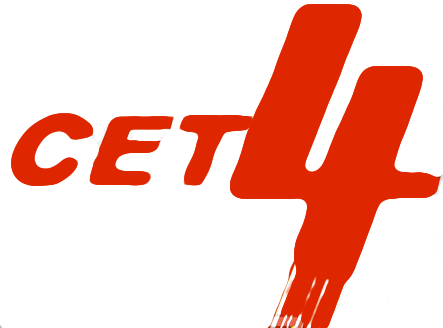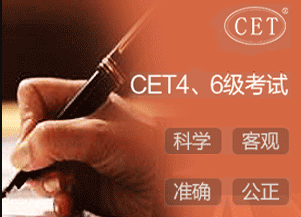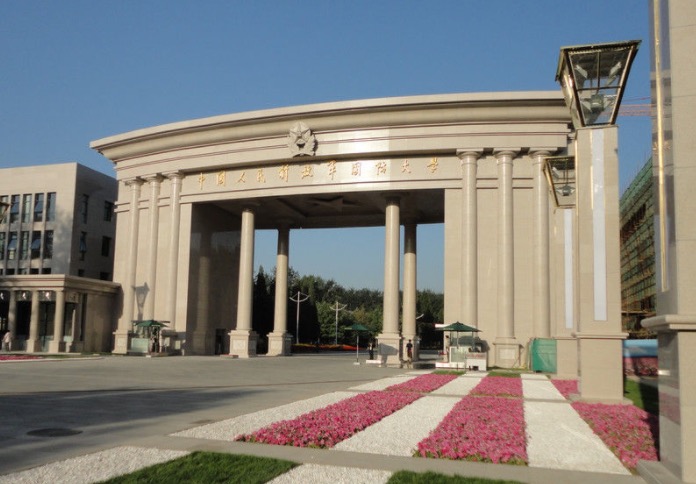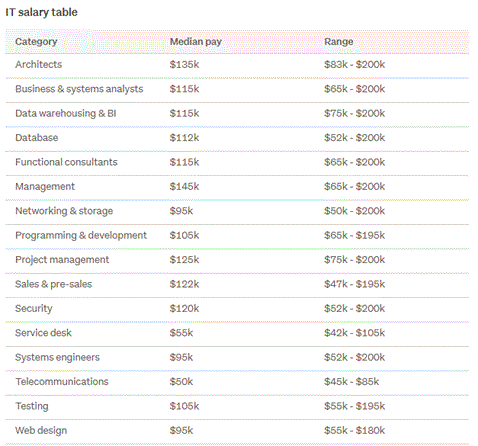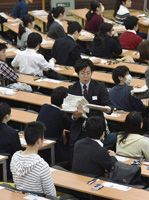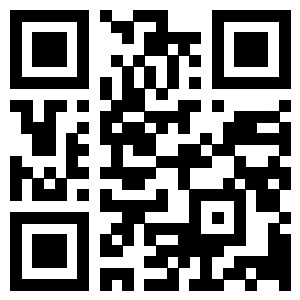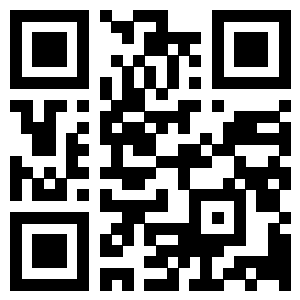大学英语四级改革后样卷题型
大学英语四级改革后样卷题型
2013年12月开始,大学英语四六级考试进行了改革,当然改革的题型变化不是很大,主要是以前很多同学靠蒙的完形填空题没有了,取而代之的是段落翻译(涉及很多中华传统文化的内容),以下是大学英语四级改革后试卷结构和样卷题型。
试卷结构
|
试卷结构 |
测试内容 |
测试题型 |
分值比例 |
考试时间 |
|
|
写作 |
写作 |
短文写作 |
15% |
30分钟 |
|
|
听力理解 |
听力对话 |
短对话 |
多项选择 |
8% |
30分钟 |
|
长对话 |
多项选择 |
7% |
|||
|
听力短文 |
短文理解 |
多项选择 |
10% |
||
|
短文听写 |
单词及词组听写 |
10% |
|||
|
阅读理解 |
词汇理解 |
选词填空 |
5% |
40分钟 |
|
|
长篇阅读 |
匹配 |
10% |
|||
|
仔细阅读 |
多项选择 |
20% |
|||
|
翻译 |
汉译英 |
段落翻译 |
15% |
30分钟 |
|
|
总计 |
100% |
130分钟
|
|||
大学英语四级改革后样卷题型
Part I Writing (30 minutes) {PDF格式预览版http://www.cet.edu.cn/cet4_2013.pdf}
Directions: For this part, you are allowed 30 minutes to write an essay. You shouldstart your essay with a brief description of the picture and then expressyour views on the importance of learning basic skills. You should write atleast 120 words but no more than 180 words. Write your essay onAnswer Sheet 1.
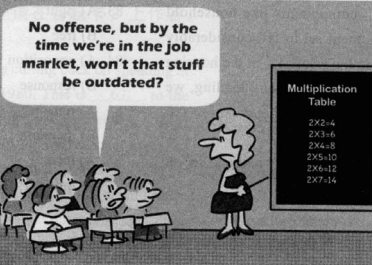
注意:此部分试题请在答题卡 1上作答。
Part II Listening Comprehension (30 minutes)
Section A
Directions: In this section, you will hear 8 short conversations and 2 longconversations. At the end of each conversation, one or more questions willbe asked about what was said. Both the conversation and the questionswill be spoken only once. After each question there will be a pause.During the pause, you must read the four choices marked A), B), C) andD), and decide which is the best answer. Then mark the correspondingletter on Answer Sheet 1 with a single line through the centre.
注意:此部分试题请在答题卡 1 上作答。
1. A) The man has left a good impression on her family.
B) The man’s jeans and T-shirts are stylish.
C) The man should buy himself a new suit.
D) The man can dress casually for the occasion.
2. A) Its price. C) Its location.
B) Its comfort. D) Its facilities.
3. A) It is a routine offer. C) It is new on the menu.
B) It is quite healthy. D) It is a good bargain.
4. A) Read the notice on the window. C) Go and ask the staff.
B) Board the bus to Cleveland. D) Get a new bus schedule.
5. A) He is ashamed of his present condition.
B) He is careless about his appearance.
C) He changes jobs frequently.
D) He shaves every other day.
6. A) The woman had been fined many times before.
B) The woman knows how to deal with the police.
C) The woman had violated traffic regulations.
D) The woman is good at finding excuses.
7. A) She got hurt in an accident yesterday.
B) She has to go to see a doctor.
C) She is black and blue all over.
D) She stayed away from work for a few days.
8. A) She will ask David to talk less.
B) She will meet the man halfway.
C) She is sorry the man will not come.
D) She has to invite David to the party.
Questions 9 to 11 are based on the conversation you have just heard.
9. A) Beautiful scenery in the countryside.
B) A sport he participates in.
C) Dangers of cross-country skiing.
D) Pain and pleasure in sports.
10. A) He can’t find good examples to illustrate his point.
B) He can’t find a peaceful place to do the assignment.
C) He can’t decide whether to include the effort part of skiing.
D) He doesn’t know how to describe the beautiful country scenery.
11. A) New ideas come up as you write.
B) Much time is spent on collecting data.
C) A lot of effort is made in vain.
D) The writer’s point of view often changes.
Questions 12 to 15 are based on the conversation you have just heard.
12. A) Having her bicycle repaired. C) Lecturing on business management.
B) Hosting an evening TV program. D) Conducting a market survey.
13. A) He repaired bicycles. C) He worked as a salesman.
B) He coached in a racing club. D) He served as a consultant.
14. A) He wanted to be his own boss.
B) He didn’t want to be in too much debt.
C) He didn’t want to start from scratch.
D) He found it more profitable.
15. A) They are all the man’s friends. C) They are paid by the hour.
B) They work five days a week. D) They all enjoy gambling.
Section B
Directions: In this section, you will hear 3 short passages. At the end of each passage,you will hear some questions. Both the passage and the questions will bespoken only once. After you hear a question, you must choose the bestanswer from the four choices marked A), B), C) and D). Then mark thecorresponding letter on Answer Sheet 1 with a single line throughthe centre.
注意:此部分试题请在答题卡 1上作答。
Passage One
Questions 16 to 18 are based on the passage you have just heard.
16. A) They shared mutual friends in school.
B) They had many interests in common.
C) They shared many extracurricular activities.
D) They had known each other since childhood.
17. A) At a local club. C) At the boarding school.
B) At Joe’s house. D) At the sports center.
18. A) Durable friendships can be very difficult to maintain.
B) One has to be respectful of other people in order to win respect.
C) Social pisions will break down if people get to know each other.
D) It is hard for people from different backgrounds to become friends.
Passage Two
Questions 19 to 21 are based on the passage you have just heard.
19. A) The art of Japanese brush painting. C) Characteristics of Japanese artists.
B) Some features of Japanese culture. D) The uniqueness of Japanese art.
20. A) To calm themselves down. C) To show their impatience.
B) To enhance concentration. D) To signal lack of interest.
21. A) How speakers can misunderstand the audience.
B) How speakers can win approval from the audience.
C) How listeners in different cultures show respect.
D) How different Western and Eastern art forms are.
Passage Three
Questions 22 to 25 are based on the passage you have just heard.
22. A) They mistake the firefighters for monsters.
B) They do not realize the danger they are in.
C) They cannot hear the firefighters for the noise.
D) They cannot see the firefighters because of the smoke.
23. A) He teaches Spanish in a San Francisco community.
B) He often teaches children what to do during a fire.
C) He travels all over America to help put out fires.
D) He provides oxygen masks to children free of charge.
24. A) He is very good at public speaking.
B) He rescued a student from a big fire.
C) He gives informative talks to young children.
D) He saved the life of his brother choking on food.
25. A) Kids should learn not to be afraid of monsters.
B) Informative speeches can save lives.
C) Carelessness can result in tragedies.
D) Firefighters play an important role in America.
Section C
Directions: In this section, you will hear a passage three times. When the passage isread for the first time, you should listen carefully for its general idea.When the passage is read for the second time,you are required to fill inthe blanks with the exact words you have just heard. Finally, when thepassage is read for the third time, you should check what you havewritten.
注意:此部分试题请在答题卡 1 上作答。
Almost every child, on the first day he sets foot in a school building, is smarter,more 26 , less afraid of what he doesn’t know, better at finding and 27 ,more confident, resourceful (机敏的), persistent and 28 than he will ever beagain in his schooling – or, unless he is very unusual and very lucky, for the rest of hislife. Already, by paying close attention to and 29 the world and people around him, and without any school-type formal instruction, he has done a task far moredifficult, complicated and 30 than anything he will be asked to do in school, or thanany of his teachers has done for years. He has solved the 31 of language. He hasdiscovered it – babies don’t even know that language exists – and he has found out howit works and learned to use it 32 . He has done it by exploring, by experimenting,by developing his own model of the grammar of language, by 33 and seeing
whether it works, by gradually changing it and 34 it until it does work. Andwhile he has been doing this, he has been learning other things as well, includingmany of the “ 35 ” that the schools think only they can teach him, and many thatare more complicated than the ones they do try to teach him.
Part III Reading Comprehension (40 minutes)
Section A
Directions: In this section, there is a passage with ten blanks. You are required toselect one word for each blank from a list of choices given in a word bankfollowing the passage. Read the passage through carefully before makingyour choices. Each choice in the bank is identified by a letter. Pleasemark the corresponding letter for each item on Answer Sheet 2 witha single line through the centre. You may not use any of the words in thebank more than once.
Questions 36 to 45 are based on the following passage.
One in six. Believe it or not, that’s the number of Americans who struggle withhunger. To make tomorrow a little better, Feeding America, the nation’s largest36 hunger-relief organization, has chosen September as Hunger Action Month.As part of its 30 Ways in 30 Days program, it’s asking 37 across the country tohelp the more than 200 food banks and 61,000 agencies in its network providelow-income inpiduals and families with the fuel they need to 38 .It’s the kind of work that’s done every day at St. Andrew’s Episcopal Church inSan Antonio. People who 39 at its front door on the first and third Thursdays ofeach month aren’t looking for God – they’re there for something to eat. St. Andrew’sruns a food pantry (食品室) that 40 the city and several of the 41 towns.Janet Drane is its manager.In the wake of the 42 , the number of families in need of food assistancebegan to grow. It is 43 that 49 million Americans are unsure of where they willfind their next meal. What’s most surprising is that 36% of them live in 44 whereat least one adult is working. “It used to be that one job was all you needed,” says St.Andrew’s Drane. “The people we see now have three or four part-time jobs and
they’re still right on the edge 45 .”
注意:此部分试题请在答题卡 2上作答。
A) accumulate I) households
B) circling J) recession
C) communities K) reported
D) competition L) reviewed
E) domestic M) serves
F) financially N) surrounding
G) formally O) survive
H) gather
Section B
Directions: In this section, you are going to read a passage with ten statementsattached to it. Each statement contains information given in one of theparagraphs. Identify the paragraph from which the information isderived. You may choose a paragraph more than once. Each paragraphis marked with a letter. Answer the questions by marking thecorresponding letter on Answer Sheet 2.
Universities Branch Out
A) As never before in their long history, universities have become instruments ofnational competition as well as instruments of peace. They are the place of thescientific discoveries that move economies forward, and the primary means ofeducating the talent required to obtain and maintain competitive advantage. But atthe same time, the opening of national borders to the flow of goods,services,information and especially people has made universities a powerful force forglobal integration, mutual understanding and geopolitical stability.
B) In response to the same forces that have driven the world economy, universitieshave become more self-consciously global: seeking students from around theworld who represent the entire range of cultures and values, sending their ownstudents abroad to prepare them for global careers, offering courses of study thataddress the challenges of an interconnected world and collaborative (合作的)research programs to advance science for the benefit of all humanity.
C) Of the forces shaping higher education none is more sweeping than the movementacross borders. Over the past three decades the number of students leaving homeeach year to study abroad has grown at an annual rate of 3.9 percent, from800,000 in 1975 to 2.5 million in 2004. Most travel from one developed nation toanother, but the flow from developing to developed countries is growing rapidly.The reverse flow, from developed to developing countries, is on the rise, too.Today foreign students earn 30 percent of the doctoral degrees awarded in theUnited States and 38 percent of those in the United Kingdom. And the numbercrossing borders for undergraduate study is growing as well, to 8 percent of theundergraduates at America’s best institutions and 10 percent of all undergraduatesin the U.K. In the United States, 20 percent of the newly hired professors inscience and engineering are foreign-born, and in China many newly hired faculty members at the top research universities received their graduate education abroad.
D) Universities are also encouraging students to spend some of their undergraduateyears in another country. In Europe, more than 140,000 students participate in theErasmus program each year, taking courses for credit in one of 2,200 participatinginstitutions across the continent. And in the United States, institutions are helpingplace students in summer internships (实习) abroad to prepare them for globalcareers. Yale and Harvard have led the way, offering every undergraduate at leastone international study or internship opportunity—and providing the financialresources to make it possible.
E) Globalization is also reshaping the way research is done. One new trend involvessourcing portions of a research program to another country. Yale professor andHoward Hughes Medical Institute investigator Tian Xu directs a research centerfocused on the genetics of human disease at Shanghai’s Fudan University, incollaboration with faculty colleagues from both schools. The Shanghai center has95 employees and graduate students working in a 4,300-square-meter laboratoryfacility. Yale faculty, postdoctors and graduate students visit regularly and attendvideoconference seminars with scientists from both campuses. The arrangementbenefits both countries; Xu’s Yale lab is more productive, thanks to the lowercosts of conducting research in China, and Chinese graduate students, postdoctorsand faculty get on-the-job training from a world-class scientist and his U.S. team.
F) As a result of its strength in science, the United States has consistently led theworld in the commercialization of major new technologies, from the mainframecomputer and the integrated circuit of the 1960s to the Internet infrastructure (基础设施 ) and applications software of the 1990s. The link betweenuniversity-based science and industrial application is often indirect but sometimeshighly visible: Silicon Valley was intentionally created by Stanford University,and Route 128 outside Boston has long housed companies spun off from MIT andHarvard. Around the world, governments have encouraged copying of this model,perhaps most successfully in Cambridge, England, where Microsoft and scores of
other leading software and biotechnology companies have set up shop around theuniversity.
G) For all its success, the United States remains deeply hesitant about sustaining theresearch-university model. Most politicians recognize the link betweeninvestment in science and national economic strength, but support for researchfunding has been unsteady. The budget of the National Institutes of Healthdoubled between 1998 and 2003, but has risen more slowly than inflation since
then. Support for the physical sciences and engineering barely kept pace withinflation during that same period. The attempt to make up lost ground is welcome,but the nation would be better served by steady, predictable increases in sciencefunding at the rate of long-term GDP growth, which is on the order of inflationplus 3 percent per year.
H) American politicians have great difficulty recognizing that admitting more foreignstudents can greatly promote the national interest by increasing international understanding. Adjusted for inflation, public funding for international exchangesand foreign-language study is well below the levels of 40 years ago. In the wakeof September 11, changes in the visa process caused a dramatic decline in thenumber of foreign students seeking admission to U.S. universities, and acorresponding surge in enrollments in Australia, Singapore and the U.K.Objections from American university and business leaders led to improvements inthe process and a reversal of the decline, but the United States is still seen bymany as unwelcoming to international students.
I) Most Americans recognize that universities contribute to the nation’s well-beingthrough their scientific research, but many fear that foreign students threatenAmerican competitiveness by taking their knowledge and skills back home. Theyfail to grasp that welcoming foreign students to the United States has twoimportant positive effects: first, the very best of them stay in the States and—like
immigrants throughout history—strengthen the nation; and second, foreignstudents who study in the United States become ambassadors for many of its mostcherished (珍视) values when they return home. Or at least they understand thembetter. In America as elsewhere, few instruments of foreign policy are as effectivein promoting peace and stability as welcoming international university students.
- 相关阅读
-
大学英语四级考试时间
大学英语四级考试时间大学英语四级考试时间每年有2次,其中上半年一次,下半年一次,正常情况下为每年的6月、12月份的第三个星期六,考试
2019-05-15 -
大学英语四级考试流程
大学英语四级考试流程 大学英语四级考证流程是有很多注意事项的,考试流程也是很多第一次考四级的同学非常关心的问题,因为只有知道
2019-05-15 -
2019大学英语四级分数分配
2019大学英语四级分数分配根据四六级考试委员会发布的信息可知,大学英语四级试卷由四个部分构成,分数分配比例依次为1、写作:15%2、
2019-05-15 -
2019年6月大学英语四级报名时间_报名网站入口
2019年6月英语四级报名时间_报名网站入口2019年6月上半年大学英语四级报名已经开始,根据四六级考试委员会发布的消息可知:1、2019年
2019-05-15 -
2019改革后全国军校名单,最新完整43所!
2019改革后全国军校名单,最新完整43所!高考填报志愿时,2019全国有哪些军校和全国军校名单是广大考生和家长朋友们十分关心的问题,2017
2019-05-15
TOPS
- 日排行/
- 周排行/
- 原创
- 日排行/
- 周排行/
- 原创
- 1 无锡学院2022年6月英语六级准考证打印入口|时间:6月1日
- 2 2022年6月英语四级作文热门话题及范文:教育不公平
- 3 泰州学院2022年6月英语六级准考证打印入口|时间:6月1日
- 4 吉林四级考试时间2022年上半年
- 5 2022年6月英语四级作文热门话题及范文:网络游戏
- 6 宿迁学院2022年6月英语六级准考证打印入口|时间:6月1日
- 7 2022年6月英语四级作文热门话题及范文:电力短缺
- 8 苏州城市学院2022年6月英语六级准考证打印入口|时间:6月1日
- 9 2022年6月英语四级作文热门话题及范文:手机的利弊
- 10 常熟理工学院2022年6月英语六级准考证打印入口|时间:6月1日

